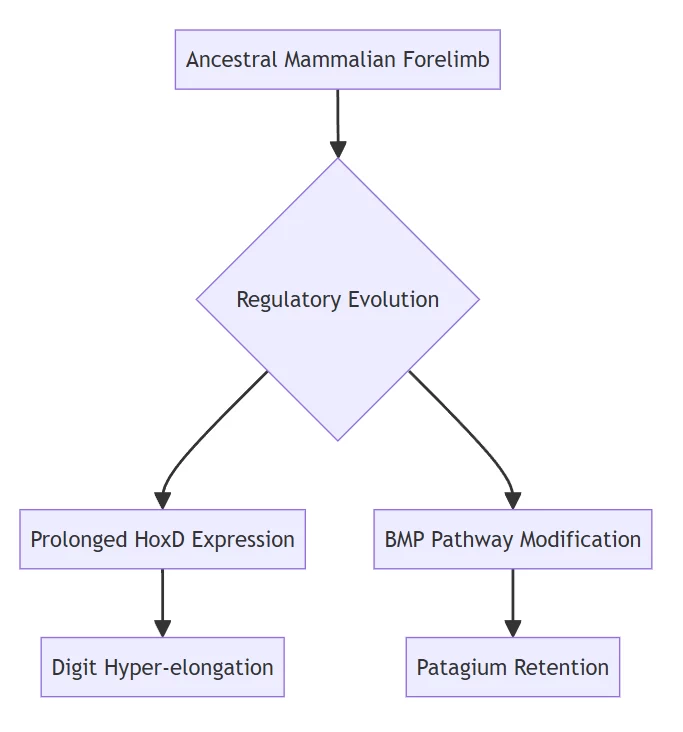evolimb.com
I. Mammalian Flight Apparatus: Chiropteran Wing Development
Morphological Transformation
Bat wings represent the most radical modification of mammalian forelimbs, characterized by:
- Digital hyper-elongation: Metacarpals and phalanges of digits II-V extended >300% compared to terrestrial mammals
- Patagium formation: Flight membrane integrating skin layers, muscle fibers, and neural networks
(Fig. 1: Myotis lucifugus wing skeletal structure)
Description: Fluorescent skeletal staining showing elongated phalanges (blue) and cartilaginous struts (red) reinforcing patagium.
Developmental Mechanism
Genetic screening reveals key innovations:
- HoxD cluster enhancement: Extended expression of Hoxd13 in autopod region drives digit elongation
- BMP regulation: Brinp3 overexpression inhibits apoptosis in interdigital tissues
- Epigenetic rewiring: BAT-specific enhancers near Fgf8 gene accelerate limb bud growth

evolimb.com II. Aquatic Transition: Cetacean Flipper Formation
Morphological Transformation
Whale forelimbs demonstrate:- Hydrodynamic shaping: Streamlined skeletal structure with fused carpals
- Digit webbing: Complete integration of soft tissues between phalanges
- Hindlimb regression: Pelvic girdle reduction to vestigial structures
(Fig. 2: Dorudon atrox forelimb fossil)
Description: Fossilized flipper showing digit convergence (yellow arrows) and reduced elbow mobility.Evolutionary Pathway
Transitional fossils reveal four-phase adaptation:- Semi-aquatic paddling (Pakicetus): Weight-bearing limbs with elongated digits
- Pelvic reduction (Ambulocetus): Detached sacrum facilitating undulatory motion
- Propulsion specialization (Basilosaurus): Ball-and-socket flipper joints enabling maneuverability
- Neuromuscular refinement (Modern cetaceans): Collagen reinforcement of leading flipper edges
Genetic Basis
- Shh downregulation: Suppresses posterior digit formation
- Hand2 enhancer deletion: Triggers pelvic apoptosis
III. Fossorial Adaptation: Limb Reduction in Squamates
A. Scincidae Lizard Limb Regression
(Fig. 3: Lerista spp. limb gradient)
Description: Radiographs showing progressive limb reduction from pentadactyl (top) to apodal (bottom) species.Evolutionary Drivers
- Substrate specialization: Sandy environments favor serpentine locomotion
- Developmental truncation: Tbx4 enhancer mutations terminate hindlimb development
Regressive Sequence
Stage Limb Elements Retained Locomotor Mode Ancestral 5 fingers + 5 toes Quadrupedal walking Intermediate 3 fingers + 0 toes Concertina movement Derived 0 fingers + 0 toes Lateral undulation B. Ophidian Limb Loss
Developmental Mechanism
- Sonic hedgehog pathway disruption: Eliminates limb bud initiation
- Hox gene repositioning: Alters axial patterning priorities
Vestigial Evidence
- Python pelvic spurs: Remnants of hindlimb girdle
- Embryonic limb bud transience: Appears at 3 days then regresses
IV. Avian Flight Specialization: Penguin Wing Transformation
Functional Morphology
(Fig. 4: Aptenodytes patagonicus skeletal wing)
Description: Comparative anatomy showing shortened humerus (H), flattened ulna (U), and fused phalanges (P).Hydrodynamic Adaptations
- Bone density increase: 30% heavier skeleton than aerial birds
- Joint rigidity: Reduced mobility at wrist and elbow joints
- Feather microstructure: Scale-like overlapping barbules resisting water penetration
Evolutionary Trade-offs
- Flight sacrifice: Wing loading exceeds aerial flight threshold
- Diving enhancement: Stroke efficiency underwater increases 40%
V. Developmental Convergence Table
Adaptation Type Taxonomic Groups Core Genetic Mechanism Morphological Outcome Elongation Bats, flying squirrels Fgf8 enhancer amplification Hyper-extension of distal elements Reduction Whales, lizards Tbx family suppression Proximal element deletion Rigidification Penguins, sea turtles Bmp4-mediated joint fusion Limited mobility + density increase Webbing Waterfowl, platypus Gremlin expression modulation Interdigital tissue retention
VI. The Evolutionary Paradox of Limb Development
Three Universal Principles
- Deep Homology Conservation
- All tetrapod limbs originate from conserved Hox-controlled patterning fields
- Modular Regulatory Evolution
- Cis-regulatory element mutations permit isolated modification without systemic disruption
- Functional Trade-off Optimization
- Aerodynamic/hydrodynamic efficiency inversely correlates with terrestrial competence
“Limb evolution showcases nature’s engineering genius—reconfiguring ancient genetic blueprints into radical new architectures while preserving core developmental logic.”
– Synthesis of Evo-Devo Principles(Fig. 5: Homologous structures across vertebrate limbs)
Description: Color-coded skeletal homology from fish fin (left) to human hand (right) showing conserved elements (blue=stylopod, green=zeugopod, red=autopod).
Data sourced from publicly available references. For collaboration or domain interest inquiries, contact: chuanchuan810@gmail.com.

